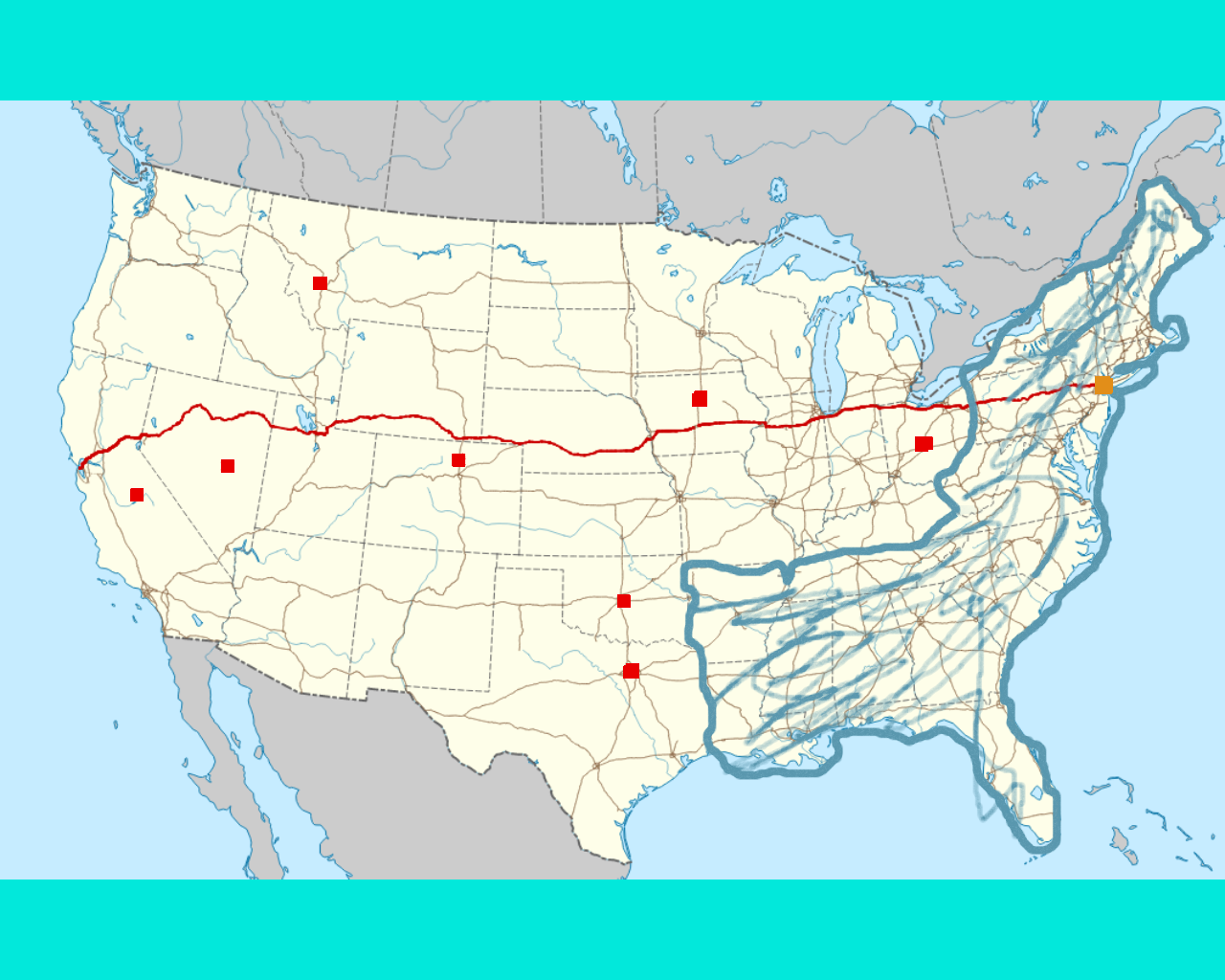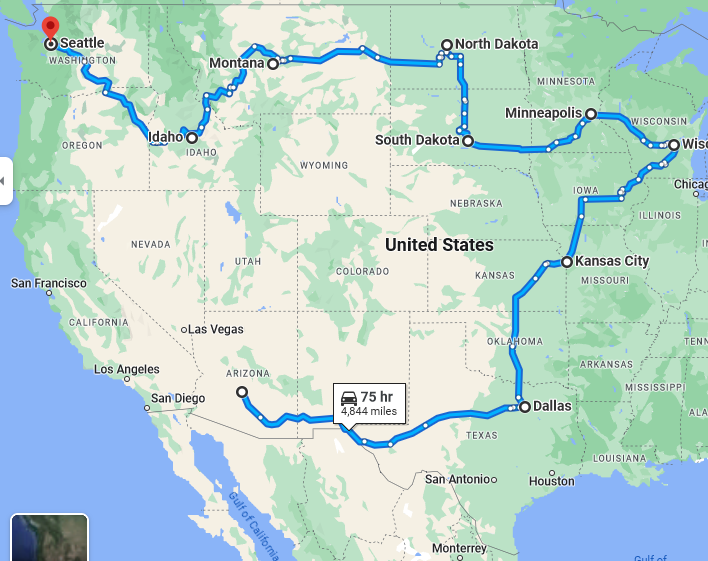Once upon a time, a man named John E. Smith wanted to make a transcontinental journey across America by road. John wanted to scour the country for the people from the math problems and see if he could lock them up in his basement get them put in an insane asylum. This was his life goal. He decided to begin doing this by traveling from coast to coast on Interstate 80. Here is a handy map to help you understand:

The red line is Interstate 80. The square red dots are places he suspects might be the states that the people from math problems live. The area filled in with cyan is the places he knows the people from math problems don’t live. The places without a red dot are places he doesn’t suspect. He pays his friend, Nathan Coughsell, to cover some ground at the same time he John traverses I-80. Here is what Nathan’s route will look like:

Nathanial will then fly back from Seattle to his home in Arizona. This route would make sure that either they found the people in the math problems or they were not in the United States. This story is about John, not Nathanial, so we will not cover Nathanial’s route in much detail.
John lives in Teaneck New Jersey. This just so happens to be where I-80 begins. I-80 goes west and ends at San Fransisco. John is going to inquire at the nearby county houses to see if there have been any “strange cases” or “odd purchases” lately.
His first stop was Cleveland. I-80 runs south of Cleveland, but I-90 runs through Cleveland and then rejoins back with I-80, so it was quite convenient to take I-77 north from I-80 for the quick detour to check on one of the large Ohio cities. The governor of Ohio said they had heard of: “A man bought 79 watermelons. He ate 5 and 69/9696 of one. How many did he have left?”. So John E. Smith was able to get him and his whole known family (for they were from the math problems too) thrown into the Ohio Insane Asylum, finally filling it to capacity. When John crossed the Indiana border, he said, “I shouldn’t have expected any less from Ohio.”
His next stop was Toledo, Ohio. He found nothing unusual there.
The next place Mr. Smith stopped was South Bend, Indiana. He inquired of the mayor, and he said that Susan from: “Jane has 12 crayons and Kim has 7 crayons. How many more crayons does Susan have than Kim?” lived not far away. The person who wrote that problem was the real culprit. He asked and the mayor stated that the man who wrote the problem was Susan’s mother, so John had her thrown on a plane to North Korea for her punishment. John took poor, forgotten Susan with him the rest of the trip. The mayor also found a soybean farmer buying extra soybeans when he had run out of space for them. John threw him in the same plane as Susan’s mom.
The next stop John made was the Chicago courthouse. He spoke with the Governor and found that the guy who wrote: “if a man commits 50 murders in one day, how many murders will he and his incompetent friend commit in 69 days?”. John sent Susan to a hotel and then found this man. Suffice to say there was a new name in the Chicago obituary the next morning. John picked Susan up in his car and they continued their trip. They continued stopping at city after city, their stops being in each of the states on the map.
Finally, they came to Cheyenne, Wyoming. He found that the whole population of Wyoming was made up of the people from the math problems. All ten of the people from the math problems growled at Smith. The battle between John E. Smith and the people from the math problems. One man pushed a bread cart at Smith with a fat man with his cheeks full on it. The fat man spat watermelon seeds at Smith at an alarming rate. Smith ducked and ran, saying as he did
“Wow, these people are more powerful than I expected. Then again, I don’t know anyone else who can eat half of 960 watermelons, so I guess I shouldn’t be surprised”.
Smith hopped on one of 20 and a half horses, the result of 41 horses split between two men. He rode this onto the cart of the man selling bread at 25 cents a loaf that sold 5 loaves in one day, knocking over the man who ate half of 960 watermelons. The cart fell on Mr. Watermelons and he was squished to death, and the bread man was trampled underfoot of the horse.
Smith said, “Two down, eight to go. Then the whole population of Wyoming (and the people from the math problems) is dead.”
Mr. Half-horse jumped on the leftover half horse and charged towards Smith. Smith struck the horse a blow from his gun. Smith had only had six cartridges before, now he was down to five. The half-horse fell, and Mr. half horse lay stunned on the ground. Smith struck him with his dagger. The other nineteen horses fled over the border to Colorado, where they became mascots for the Denver Broncos. Smith wheeled around to see a man carrying a barrel full of water with a little spigot leaking at a rate of 3/4 of a liter per hour for 10 5/8 days. The man had put $200 in the bank for 19 years at a compound interest rate of 2.75% and then spent all the money on the barrel of water and running for King of Wyoming. (and yes, if you’re wondering, the barrel does count towards the population of Wyoming because WHY NOT). Smith grabbed his axe and cracked the barrel open, spilling water on the man with the interest rate.
“TAKE THAT” yelled Smith, whacking the dull end of the axe against the man’s head. “Five down, five to go,” Smith muttered under his breath.
Jane and Kim from Susan’s math problem faced him, throwing larger-and-sharper-than-normal crayons at him. Smith held up a piece of the water barrel and eight of the nineteen crayons hit it. Smith received his first wound of the battle: A purple crayon to his shin, and a red one to his waist. Smith winced and pulled them out of his wounds, hurling them back at Kim and Jane. They hit their mark: The left eye of each. A car salesman the ran Kim and Jane over with one of his 20 red Ford F150s he needed to get gas for, and charged at Smith. He ran out of gas just in time. Smith fired three shots, killing the man.
“Two more,” quoth Smith.
Johnny (not John E.) was the rich boy who went to the candy shop and bough 1000 candies on Monday. On Tuesday, he at 1/4 of them. Now Johnny has diabetes so he can’t eat his candy. Johnny threw 100 of his candies rapid fire at John E. Smith retaliated by shoving one down Johnny’s throat. Johnny cried out in pain as his blood sugar skyrocketed. Smith let him die while he dealt with the last person: The guy who worked at the general store during the civil war and kept track of his sales. Two shots of Smith’s pistol came quickly. One bullet missed. The second grazed his head, stunning him. Two sharp crayons in the eye and he was dead.
Smith looked around him at his fallen enemies. His wounds throbbed, and he winced. There was nobody else for miles around, and he didn’t have cell service. He had no choice. He pulled out his iPhone SE 2016 (the oldest model that still gets updated) and hit the Emergency SOS button. It went through to the satellites and transmitted the message to the closest hospital. Thirty minutes later, a rescue helicopter landed near Smith. They administered to his wounds, and removed all the crayon wax. They bandaged him and took him back to the hospital where he lay for three days before he could go about like normal again. He phoned Nathanial and told him he could come back; Smith had annihilated the people in the math problems on his own. Smith went to Denver and got a plane to New York. From there he ubered back to his home, and had completed his life’s mission. He raised Susan as his own daughter and lived happily ever after.
THE END